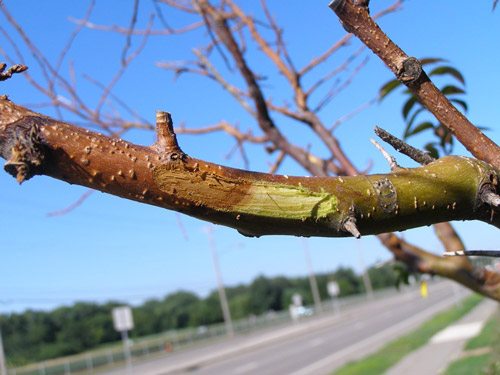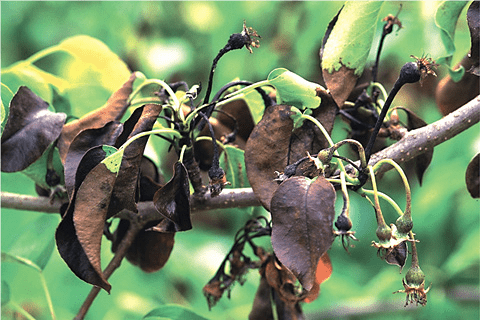What Is Fire Blight?
Fire blight is a highly destructive bacterial disease that poses a serious threat to many trees in the St. Louis area. Caused by the bacterium Erwinia amylovora, this aggressive pathogen specifically targets plants in the rose family, including popular landscape trees like Bradford pears, crabapples, hawthorns, and mountain ash. The disease gets its name from the distinctive scorched appearance it gives infected trees, causing the leaves and branches turn dark brown or black and look as though they've been burned by fire.
What makes fire blight particularly dangerous is its speed and ease of transmission. The bacteria can kill entire branches or even whole trees in a single growing season, spreading rapidly through rain, wind, insects, and contaminated tools. Fire blight thrives in the warm, humid conditions common during St. Louis springs and early summers, becoming active when temperatures rise above 65°F and spreading quickly during wet weather.
Signs Your Tree Might Have Fire Blight
The sooner you identify fire blight, the better chance you have of saving your tree and preventing spread to other plants in your landscape. Watch for these telltale signs:
Visual Symptoms
- Shepherd's crook appearance - New shoots and branch tips bend downward in a distinctive hook or "J" shape
- Scorched, fire-burned look - Leaves and branches appear blackened or dark brown as if burned by fire
- Wilted flowers and leaves - Blossoms turn brown or black and wilt, but remain attached to the branch instead of falling off
- Dead leaves clinging to branches - Unlike normal leaf drop, fire blight leaves stay attached through the growing season and into winter
Physical Signs on the Tree
- Bacterial ooze - Sticky, amber-colored or milky droplets seeping from infected branches, twigs, or cankers
- Sunken, dark cankers - Water-soaked, darkened areas of bark that become sunken and may crack around the edges
- Reddish-brown streaks - Discoloration visible under the bark when peeled back, showing internal infection
- Shriveled, mummified fruit - Infected fruit turns dark, dries out, and remains hanging on the tree
How Fire Blight Spreads to Other Trees
This bacterial disease is highly contagious and can quickly move from one tree to another through several pathways, making containment critical once an infection is detected. The bacteria can survive winter in infected bark cankers and become active again in spring when temperatures warm up. Once activated, a single infected tree can produce millions of bacterial cells that spread throughout your property and to neighboring landscapes. Be mindful of these common occurrences that can spread fire blight.
- Insects as carriers - Bees, flies, and other insects are attracted to the sweet, sticky bacterial ooze and carry the bacteria to healthy flowers and wounds on other trees
- Rain and wind - Wind-blown rain and water splash move bacteria from infected trees to nearby healthy plants
- Weather events - Hail, strong winds, and storms create wounds in trees while simultaneously spreading bacteria, creating perfect conditions for new infections
- Contaminated pruning tools - Using the same pruning shears on infected and healthy trees without disinfecting spreads bacteria directly
- Irrigation systems - Overhead sprinklers and watering can splash contaminated water from tree to tree
- Foot traffic - Walking between infected and healthy trees during wet conditions can transfer bacteria on shoes and clothing
Common Trees in Missouri at Risk from Fire Blight
Many of the most popular landscape trees in the St. Louis area are unfortunately also the most vulnerable to fire blight. All members of the rose family (Rosaceae) are potential targets, but some are particularly susceptible due to their genetics and growing characteristics.
Highly Susceptible Trees
- Ornamental Pears (Bradford, Cleveland, Aristocrat) - These extremely popular street and landscape trees are among the most vulnerable to fire blight. Their rapid spring growth and abundant flowering create ideal conditions for bacterial infection, and once infected, the disease spreads quickly through their soft tissue.
- Crabapples - While beautiful in bloom, crabapples' profuse flowering makes them prime targets for fire blight. The bacteria easily enter through the numerous blossoms, and the disease can devastate these trees in a single season, especially younger specimens.
- Hawthorns - These native trees are highly susceptible with very few resistant varieties available. Their thorny branches create natural wounds that provide easy entry points for bacteria, and their spring flowering coincides perfectly with fire blight's active period.
- Mountain Ash - Popular for their attractive berries and fall color, mountain ash trees are extremely vulnerable to fire blight. The disease often kills these trees outright, as they have little natural resistance to bacterial invasion.
Moderately Susceptible Trees
- Apple Trees - While some apple varieties show resistance, many common types are susceptible to fire blight. Fruit production makes them attractive to insects that can spread the disease, and pruning wounds from annual maintenance can provide entry points.
- Serviceberry (Juneberry) - These native trees can be affected by fire blight, though they typically show more resistance than ornamental pears or crabapples. Still, they require monitoring during wet spring weather.
- Pyracantha (Firethorn) - These thorny shrubs are susceptible to fire blight, with their dense branching structure making detection and treatment challenging once infection occurs.
Treatment and Prevention for Fire Blight
Once the disease takes hold, management becomes challenging and sometimes impossible. However, with the right approach, you can protect your trees and manage infections when they occur.
- Choose resistant varieties - When planting new trees, select cultivars known for fire blight resistance rather than highly susceptible species
- Proper fertilization - Avoid excessive nitrogen fertilizer, especially in late spring and summer, as it promotes soft, succulent growth that's more vulnerable to infection
- Strategic pruning - Maintain open tree canopies to improve air circulation and reduce humidity around branches, while avoiding heavy pruning that stimulates vulnerable new growth
- Water management - Avoid overhead irrigation during bloom periods and don't water during wet weather when bacteria spread most easily
Professional Treatment Options
- Precise pruning removal - Infected branches must be cut at least 8-12 inches below visible damage into healthy wood, with tools sterilized between each cut to prevent spread
- Copper-based preventive sprays - Applied during dormant season to reduce bacterial buildup on bark and buds before spring infection periods
- Antibiotic treatments - Professional application of bactericides during specific weather conditions and bloom periods when infection risk is highest
- Complete tree removal - When infection reaches the main trunk or root system, removing the tree may be necessary to prevent spread to other landscape plants
Fire blight spreads rapidly and can kill entire trees in a single season, and can be too dangerous to handle on your own. Ballwin Tree Service's ISA-certified arborists have the specialized knowledge and equipment to accurately diagnose fire blight and implement effective treatment strategies. Whether you've spotted symptoms or want preventive care for susceptible trees, contact us today for a professional tree health assessment. When it comes to fire blight, early action saves trees.



